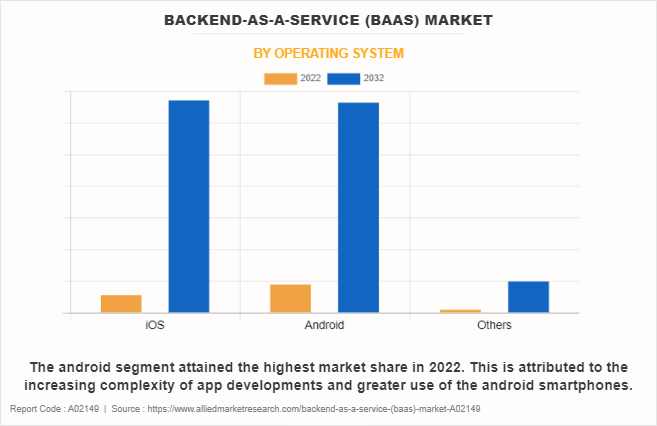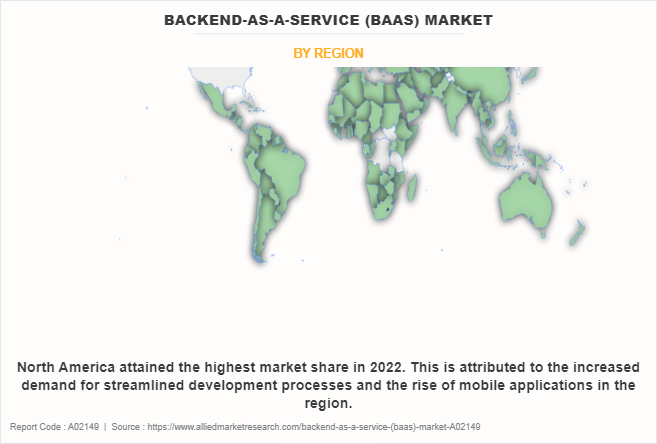Backend-as-a-Service (BaaS) Market Insights, 2032
The global backend-as-a-service (BaaS) market size was valued at $3.1 billion in 2022, and is projected to reach $28.7 billion by 2032, growing at a CAGR of 25.3% from 2023 to 2032.
The developing demand for mobile and web applications is driving the market. As corporations strive to offer seamless virtual experiences, reliance on strong backend infrastructure will become important, which drives the backend-as-a-service market growth. Furthermore, the rise in the adoption of cloud-based infrastructure serves as a powerful driving force for the acceleration of the backend-as-a-service market. The synergy between cloud computing and BaaS simplifies backend development as well as improves scalability, protection, and worldwide accessibility, making it a compelling preference for businesses navigating the complexity of the digital landscape.

However, the growing backend-as-a-service business dealing with enormous challenging situations due to records protection and privacy issues and challenges associated with the complexity of integration. On the contrary, the growing popularity of serverless computing solutions is expected to generate lucrative opportunities for the BaaS market. Serverless computing is becoming more innovative as organizations prefer faster, scalable solutions that eliminate the need for complex backend maintenance. In addition, the growing IoT ecosystem is expected to accelerate the backend-as-a-service industry growth as enterprises embrace IoT technology for operational efficiency and continuous enhancement.
Backend-as-a-service is a cloud computing service architecture that serves as middleware, allowing developers to connect their web and mobile apps to cloud services via APIs and software development kits (SDK). It is a third-party solution that enables the developer to create an application or website without having to modify the software’s backend. As an effect, the developer can complete all backend services in one go, allowing them to concentrate on frontend development.
The report focuses on growth prospects, restraints, and trends of the backend-as-a-service market forecast. The study provides Porter's five forces analysis to understand the impact of various factors such as bargaining power of suppliers, competitive intensity of competitors, threat of new entrants, threat of substitutes, and bargaining power of buyers on the backend-as-a-service market outlook.
Top Impacting Factors
Rise in Demand for Mobile and Web Applications
The growing demand for mobile and web applications is driving the expansion of the backend-as-a-service market. As businesses attempt to deliver seamless digital experiences, the reliance on effective backend infrastructure becomes increasingly important. BaaS provides a strategic solution by providing ready-made backend services, that allow developers to focus on frontend development.
According to BuildFire, there are around 6.3 billion smartphone users worldwide, with 1.14 billion tablet users growing at a rate of approximately 7% each year, which has led organizations to seek efficient ways to manage their backend processes. BaaS improves backend development, reducing time-to-market for applications. This demand-driven growth is further fueled by the need for scalable and agile solutions in the evolving tech landscape. Hence, such factors fuel the expansion of the backend-as-a-service market.
Widespread Adoption of Cloud-based Infrastructure
The surge in adoption of cloud-based infrastructure is fueling the growth of the backend-as-a-service market size. The synergy between cloud computing and BaaS simplifies backend development while also boosting scalability, security, and worldwide accessibility, thereby making it a viable choice for businesses navigating the complexities of the digital landscape. As businesses migrate to the cloud, the demand for simplified backend development grows. BaaS emerges as a strategic option, allowing developers to reduce backend complexity and focus on creating innovative front-end experiences.
In addition, key players in the market are innovating new products to sustain their growth in the market. For instance, in November 2023, AWS Amplify announced a public preview of its code-first developer experience (Gen 2), enabling developers to build full-stack apps using TypeScript. Gen 2 shifts to a code-first approach that allows developers to express app requirements - data model, business logic, authorization rules - in TypeScript. The necessary cloud infrastructure is automatically deployed based on the app code, without explicit infrastructure definitions. Thus, such strategies drive the growth of the BaaS market.
Data Privacy and Security Concerns Associated with BaaS
The backend-as-a-service market is experiencing a contraction due to the rise in concerns about data privacy and security linked with BaaS. As businesses rely steadily on BaaS providers to streamline their backend operations, the potential vulnerability of confidential information stored in the cloud becomes a concern. Data breaches and cyber threats have heightened these concerns among businesses and users alike. Organizations are concerned about the results of breached data integrity and unauthorized access, which prevents the widespread adoption of BaaS solutions.
Segment Review
The backend-as-a-service market is segmented into service type, operating system, enterprise size, industry vertical, and region. On the basis of service type, the market is differentiated into professional services, support and maintenance, access and identity management, usage analytics, and others. On the basis of operating system, the market is divided into iOS, android, and others.
On the basis of enterprise size, the market is categorized into large enterprises, and small and medium-sized enterprises. By industry vertical, the market is segregated into BFSI, IT and telecom, healthcare, retail and e-commerce, manufacturing, media and entertainment, public sector, and others. Region-wise, the market is studied across North America, Europe, Asia-Pacific, and LAMEA.

By operating system, the android segment acquired a major backend-as-a-service market share in 2022, owing to the great use of the android operating system. With the increasing demand for feature-rich and interconnected mobile applications, BaaS provides a simplified solution by delivering pre-built backend capability. This reduces development time and resources, making it easier for developers to build sophisticated android apps without extensive backend experience. However, the iOS segment is expected to be the fastest-growing segment during the forecast period. The increasing complexity of mobile app development is fueling the emergence of the backend-as-a-service market in iOS.

Region-wise, North America dominated the market in 2022. This is attributed to the huge presence of telecom firms and end-user industries that are constantly adapting emerging technologies to improve business efficiency. However, Asia-Pacific is considered to be the fastest-growing region during the forecast period, owing to the increasing mobile applications and internet utilization throughout the region which increased the demand for quick and efficient app development solutions.
Competition Analysis
Competitive analysis and profiles of the major players in the backend-as-a-service market include 8basе Inc., Amazon Web Services, Inc., Back4App Inc., Kuzzle, MongoDB, Inc., Google LLC, Microsoft Corporation, Progress Software Corporation, Oracle Corporation, and Kii Corporation. These players have adopted various strategies to increase their market penetration and strengthen their position in the backend-as-a-service industry.
Recent Agreement in the Market
In March 2022, MongoDB, Inc., the leading modern, general-purpose database platform, announced a significant expansion of a multi-year strategic collaboration agreement (SCA) with Amazon Web Services, Inc. (AWS). Under this six-year agreement, MongoDB and AWS have committed to a broad range of initiatives to make it easier for joint customers to advance their cloud adoption journey, including integrated go-to-market activities across sales and marketing, developer enablement and training through shared developer relations activities, and both technology integrations and commercial incentives to streamline the migration of on-premises workloads to MongoDB Atlas on AWS.
Recent Product Launch in the Market
In November 2023, AWS Amplify announced a public preview of its code-first developer experience (Gen 2), enabling developers to build full-stack apps using TypeScript. Gen 2 shifts to a code-first approach that allows developers to express app requirements - data model, business logic, authorization rules - in TypeScript. The necessary cloud infrastructure is automatically deployed based on the app code, without explicit infrastructure definitions.
Recent Product Development in the Market
In May 2022, Google announced several updates to Firebase, Google's popular backend-as-a-service platform. The focus is mostly on deeper integrations with the rest of Google's developer tools and platforms, the overall developer ecosystem, as well as several updates that help developers better secure their applications.
Market Landscape and Trends
According to the India edition of Deloitte’s 2022 Global TMT (Technology, Media and Entertainment, Telcom) report, India is expected to have a billion smartphone users by 2026 as 5G services are rolled out. Over the period, India is also set to become the second-largest manufacturer of smartphones. Smartphone shipments in India are expected to reach 1.7 billion units from 2022 to 2026 creating a $250 billion market on the back of major policy reforms.
In Africa, according to "The Mobile Economy 2023" released by the Global System Operators and Manufacturers Association (GSMA), the region is expected to witness a surge in smartphone adoption and the rise of 5G technology. Furthermore, by 2030, smartphone adoption is projected to increase to 87% in Sub-Saharan Africa, up from 51% in 2022. This rapid growth is due to the decline in prices of smartphones and the increasing number of youngers embracing digital technologies. Hence, organizations are increasingly adopting BaaS solutions to streamline their app development process and deliver cloud-based solutions that can easily handle the workloads associated with these digital services.
Key Benefits for Stakeholders
- This report provides a quantitative analysis of the market segments, current trends, estimations, and dynamics of the backend-as-a-service market analysis from 2022 to 2032 to identify the prevailing backend-as-a-service market opportunity.
- The market research is offered along with information related to key drivers, restraints, and opportunities.
- The Porter's five forces analysis highlights the potency of buyers and suppliers to enable stakeholders to make profit-oriented business decisions and strengthen their supplier-buyer network.
- In-depth analysis of the backend-as-a-service market segmentation assists to determine the prevailing backend-as-a-service market opportunities.
- Major countries in each region are mapped according to their revenue contribution to the market.
- Market player positioning facilitates benchmarking and provides a clear understanding of the present position of the market players.
- The report includes the analysis of the regional as well as backend-as-a-service market trends, key players, market segments, application areas, and market growth strategies.
Backend-as-a-Service (BaaS) Market Report Highlights
| Aspects | Details |
| Market Size By 2032 | USD 28.7 billion |
| Growth Rate | CAGR of 25.3% |
| Forecast period | 2022 - 2032 |
| Report Pages | 347 |
| By Service Type |
|
| By Operating System |
|
| By Enterprise Size |
|
| By Industry Vertical |
|
| By Region |
|
| Key Market Players | MongoDB, Inc., Kuzzle, 8base Inc., Oracle Corporation, Kii Corporation, Microsoft Corporation, Amazon Web Services, Inc., Google LLC, Progress Software Corporation, Back4App Inc. |
Analyst Review
BaaS frees businesses from expensive and time-consuming tasks, allowing them to focus on the frontend. It provides access to pre-packaged technology such as APIs and SDKs (Software Development Kit). BaaS vendors provide pre-written software for activities that take place on servers, such as user authentication, database management, remote updating, and push notifications (for mobile apps), as well as cloud storage and hosting.
In addition, key players in the BaaS market adopt partnership, product development, and product launch as their key development strategy to sustain their growth in the market. For instance, in September 2023, Oracle Corporation and Microsoft Corporation announced Oracle Database@Azure, which gives customers direct access to Oracle database services running on Oracle Cloud Infrastructure (OCI) and deployed in Microsoft Azure datacenters. Oracle Database@Azure delivers all the performance, scale, and workload availability advantages of Oracle Database on OCI with the security, flexibility, and best-in-class services of Microsoft Azure, including best-in-class AI services such as Azure OpenAI. This combination provides customers with more flexibility regarding where they run their workloads. It also provides a streamlined environment for cloud purchasing and management of Oracle Database and Azure services. Thus, such strat?gi?s prop?l th? incr?as? of th? back?nd-as-a-service market.
The COVID-19 pandemic prop?ll?d the growth of the backend-as-a-service market. Th? pand?mic b?com? technology-driv?n with hug? adoption of traits consisting of work-from-home, onlin? r?tail, pickup/shipping off?rings, entertainment-as-a-service, and t?l?m?dicin?. This increased the r?lianc? on cloud-bas?d s?rvic?s, including BaaS, as busin?ss?s sought scalabl? back?nd solutions to support their applications.
Some of th? important play?rs profil?d within th? r?port includ? 8bas? Inc., Amazon W?b S?rvic?s, Inc., Back4App Inc., Googl? LLC, Kii Corporation, Kuzzl?, Microsoft Corporation, MongoDB, Inc., Oracl? Corporation, and Progr?ss Softwar? Corporation. Th?s? play?rs hav? adopted num?rous strategies to increase their mark?t p?n?tration and strengthen th?ir position in th? backend-as-a-service market.
The backend-as-a-service (BaaS) market is segmented into service type, operating system, enterprise size, industry vertical, and region. On the basis of service type, the market is differentiated into professional services, support and maintenance, access and identity management, usage analytics, and others. On the basis of operating system, the market is divided into iOS, android, and others. On the basis of enterprise size, the market is categorized into large enterprises, and small and medium-sized enterprises. By industry vertical, the market is segregated into BFSI, IT and telecom, healthcare, retail and e-commerce, manufacturing, media and entertainment, public sector, and others. Region-wise, the market is studied across North America, Europe, Asia-Pacific, and LAMEA.
North America is the largest regional market for Backend-as-a-Service (BaaS).
The backend-as-a-service (BaaS) market size was valued at $3,054.10 million in 2022 and is projected to reach $28,650.93 million by 2032, growing at a CAGR of 25.3% from 2023 to 2032.
The key players operating in the backend-as-a-service (BaaS) market include 8base Inc., Amazon Web Services, Inc., Back4App Inc., Kuzzle, MongoDB, Inc., Google LLC, Microsoft Corporation, Progress Software Corporation, Oracle Corporation, and Kii Corporation.
Loading Table Of Content...
Loading Research Methodology...


